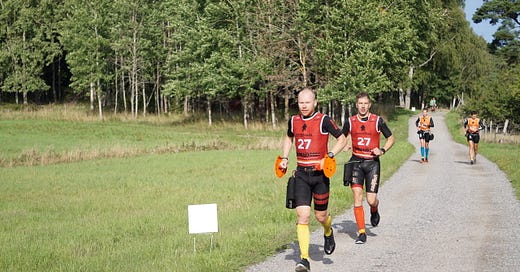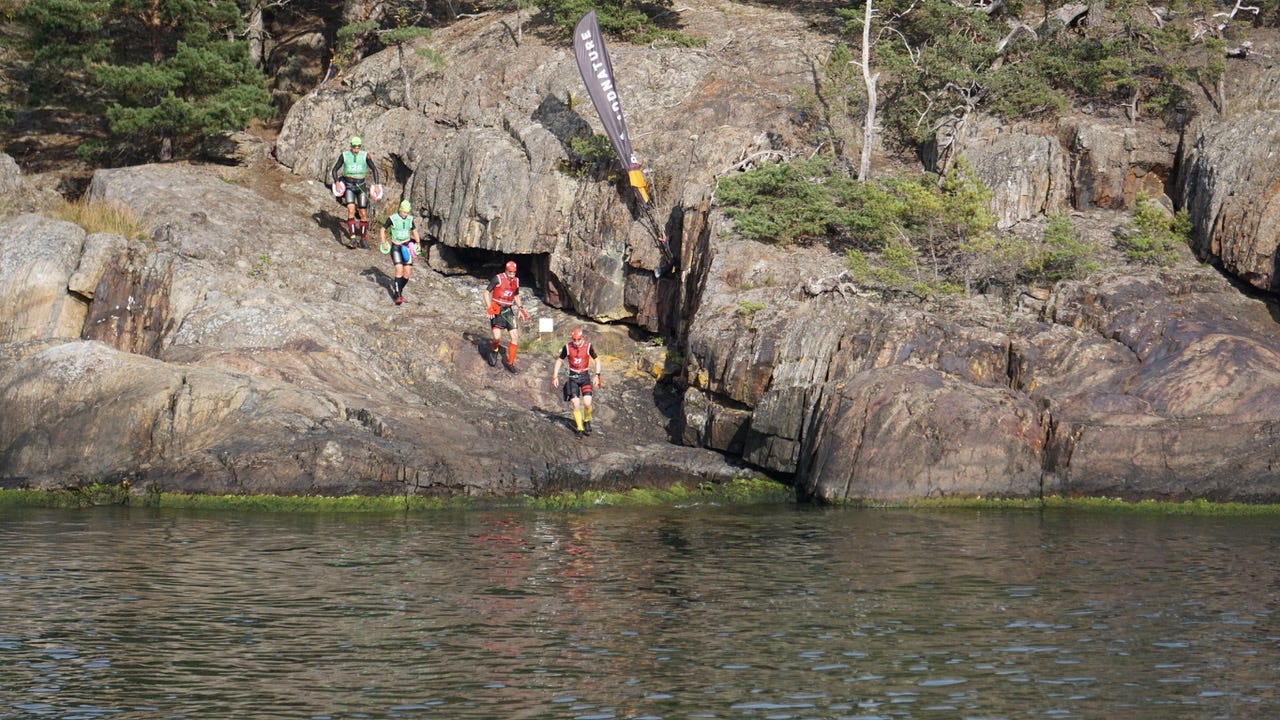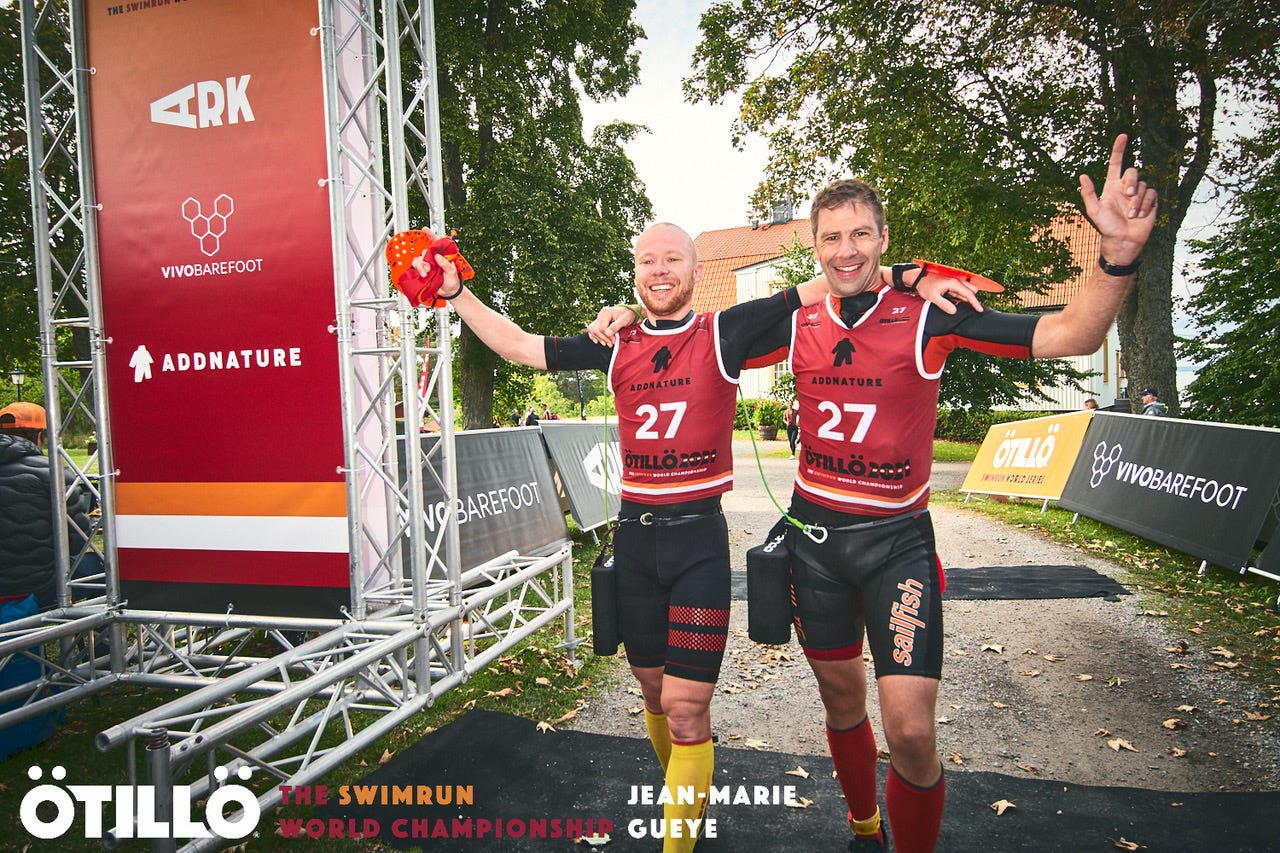In this Substack, SwimRun duo Sander and Bart blog weekly about their journey to the starting line of the Ötillö, the birthplace of the sport in Sweden. In 2025, it will once again serve as the World Championship of SwimRun. We are sharing training tips and SwimRun events, including those in the Netherlands, hoping to accelerate the growth of this relatively new sport.
De Nederlandse versie vind je HIER.
Time for the second interview in our series ‘Those Who Went Before Us’; this time with the duo Erik Schröder and Niels Grote Beverborg. Recognized SwimRun elites whom we encountered, among other places, at Het Rondje Eilanden and the Sure2Sure SwimRun in Luxembourg. Well, at the start and finish at least—during the race they were too far ahead 😅.
With athletes of this caliber, I assumed they had qualified for the World Championship through the standard route, but that turned out not to be the case. In fact, they needed two attempts to get a wildcard. “The first year, at the end of 2019, we sent a fairly neutral wildcard application which got rejected. The next year we did a bit more boasting — we were the Dutch SwimRun team after all — and that time we got the wildcard.”
In this duo, Erik is the stronger swimmer and Niels the better runner. Unlike our current method, they remain tethered to each other with a bungee cord for the entire race. Even during the runs, where we usually disconnect to run side by side without pressuring each other. Niels is very clear on this: “It’s actually really nice to stay connected. The one in the back just has to follow along and doesn’t need to think about anything else. That’s Erik when we run and me when we swim. Head down and paddle — it’s great.” Definitely something for us to test.
Luckily, during the Backyard SwimRun in ‘t Twiske we’ll have ten laps to experiment with all sorts of things. Like using a pull buoy instead of calf sleeves, for example. Erik: “During the World Championship, we used a small pull buoy, like the ones you use in a pool. Now I’d go with a slightly bigger one. Attach it with elastic to your thigh and to your belt, so you can just flip it in or out.” We still need to figure out how that works when you also rotate the belt between swimming and running. Because that’s important too — being able to connect the 'wrong' way around, in case the person leading the swim or run suddenly struggles and needs help instead of giving it.
Enough about gear, let’s talk training. Like us, Erik and Niels mostly trained separately. Niels did that for a while in Stockholm, where the swimming pools are really great. There are many pools, they're often open, and always have a few lanes reserved for fast swimmers. And those lanes were full of SwimRunners, very different from the “fast lanes” in the Netherlands filled with breaststrokers.
But they trained together too. A weekend away, enjoying training in new locations. Completing the online Beowulf ranking, where the swim and run distances are added up individually, but can easily be done as a duo. They also swam together a few times in the canal between Groningen and Assen. “That wasn’t really allowed, the rowers gave us some weird looks.” And then there’s their ‘private training location’ at the Paterswoldsemeer. Near Zuidlaren there’s another great spot: the Hulseboschgat and surrounding nature reserve. “The lake itself is small, just a few hundred meters across, but the surrounding area is beautiful and much hillier than, say, Lauwersoog, which is completely flat. And Ötillö is still kind of hilly too, with all those islands constantly going up and down.” Even further south is another great training spot at Gasselterveld.
On to the race itself. First the big question: would you do the World Championship again, or was it a once-in-a-lifetime thing? The guys are quick to agree. “We’d definitely want to do it again. It was a really amazing experience, the course is incredible. Truly beautiful. But the preparation takes a lot of time and effort. So shorter events are easier to fit into family life.”
The toughest part of the course? Definitely the longer swims and runs, especially the long run over Ornö. “But as some other participants said when we were standing by a little logger’s cabin — once you’re past that long stretch, you’re good. That’s the charm of SwimRun: 40 transitions — the variety is perfect.”
Not those first little islands then, the ones full of rocks and stones? “Those are tricky, for sure. You’re still close behind other racers and not always paying attention. And if you’re tethered, it’s easy to trip and fall. They’re not fast islands and there’s plenty of time to make up later, so don’t try to win the race there.”
Food-wise: did you bring anything or mostly ate at the aid stations? “We brought a few gels, but we also ate a lot from the stations. Don’t expect Ironman-style gels or bars though. It’s mostly regular snacks — nuts, chips, chocolate (Pommeline’s Twix bars!), and even meatballs.”
“At the same time — how much can you carry? Those suits are tight and have few pockets. We didn’t have a kangaroo vest or anything, so could only bring a few gels.” Niels: “Next time I’d definitely eat more during the day. I was looking at photos — we were completely empty. I felt so nauseous. I haven’t had that happen since, during ultratrails I eat everything I see. Looking back, people eat way more nowadays, and I’d do the same.”
Erik: “I didn’t feel nauseous. But yeah, I was in rough shape at the end. I’d do more running in advance — longer distances too. Back then I mostly stuck to half marathon distances or less. Except that one time when Niels talked me into doing a trail on the Veluwe. He mapped out a 50 or 60 km route. We started off casually, but after 40 km I was completely wrecked and so happy to see the car. That extra loop Niels did? Not an option for me.”
Finally: do you have any plans for the (near) future?
Erik: “First I just want to get back to training a few times a week consistently. That’s not always easy with family life.” Niels, on the other hand, has gone all-in on ultratrails: “A few weeks ago in Chianti, over 120km with more than 5,000 meters of elevation gain. Beautiful area, but there was so much rain. It got really slippery in the sucking mud.”
In the meantime, the guys are building a nice bucket list. “We’d still love to do that race in the Alps (Engadin). And Scilly, off the southwest coast of England, but that one’s pretty hard to reach.” And if Bart’s big dream comes true and a TVTAS-SwimRun is created, would you join (TVTAS is an abbreviation for the Dutch Waddeneilanden Texel, Vlieland, Terschelling, Ameland and Schiermonnikoog)? “That sounds seriously awesome. It would definitely be a challenge with the tides, the distance, and the nature reserves. But hey, Ötillö also started as a crazy idea from a few guys…”







